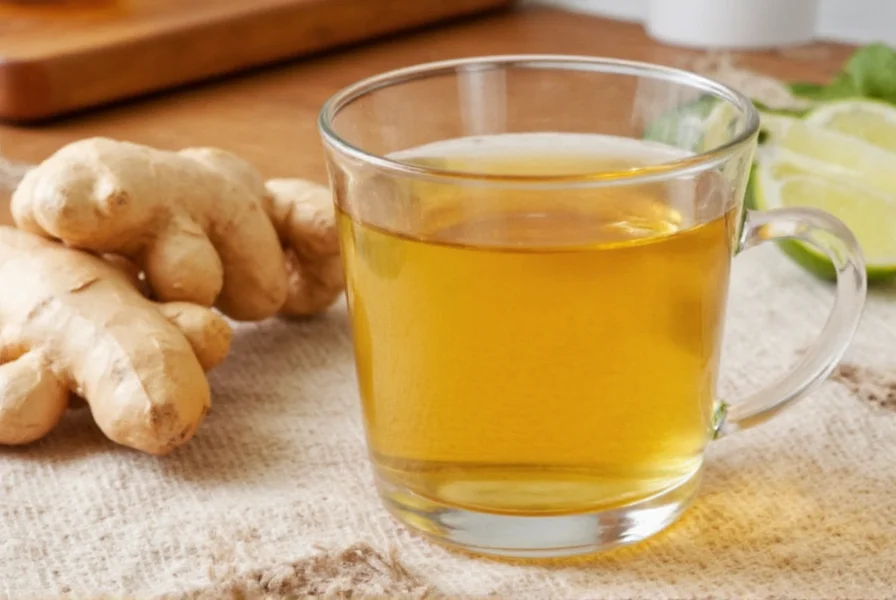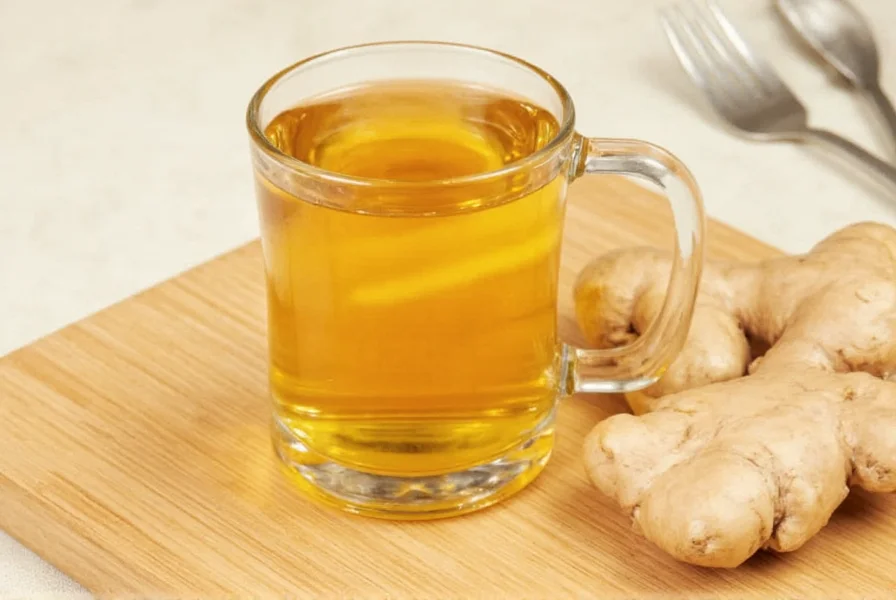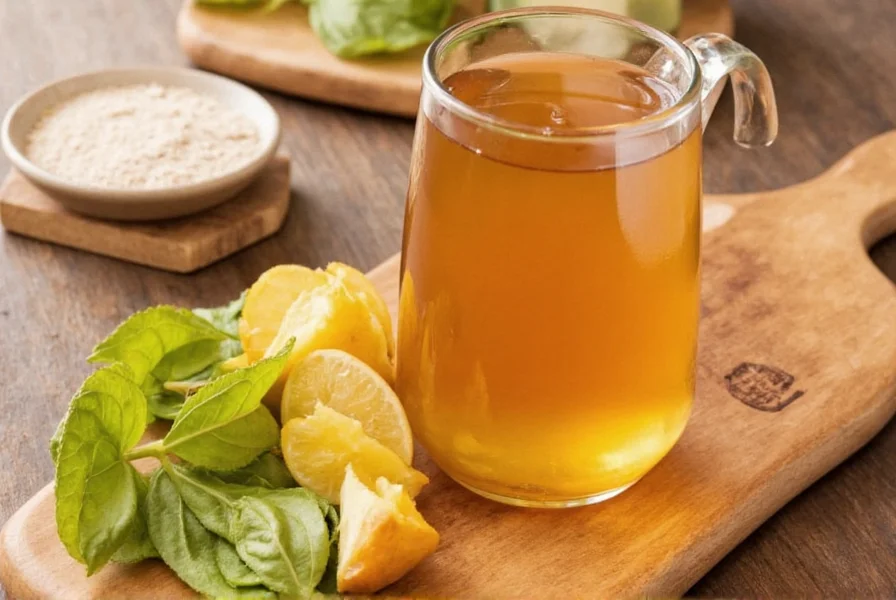The simplest way to make ginger tea is to slice 1-2 inches of fresh ginger root, boil it in 2 cups of water for 10-15 minutes, then strain and add lemon or honey to taste. For stronger flavor, crush the ginger before boiling. This basic ginger tea recipe requires only ginger, water, and optional sweeteners.
Making ginger tea at home is a straightforward process that yields a soothing, aromatic beverage with numerous health benefits. Whether you're seeking relief from nausea, a digestive aid, or simply a comforting warm drink, fresh ginger tea delivers potent flavor and wellness properties. This guide provides a foolproof method for brewing the perfect cup, along with variations to suit different tastes and needs.
Essential Ingredients and Equipment
Before you start making ginger tea, gather these basic items. Quality ingredients make a significant difference in the final flavor profile of your homemade ginger tea.
| Item | Quantity | Notes |
|---|---|---|
| Fresh ginger root | 1-2 inches | Choose firm, smooth-skinned ginger with no wrinkles |
| Water | 2 cups | Filtered water improves taste |
| Lemon | 1/2, sliced | Optional but recommended for balanced flavor |
| Honey or maple syrup | To taste | Natural sweeteners complement ginger's spice |
Step-by-Step Ginger Tea Preparation
Follow these detailed instructions to make authentic ginger tea that maximizes both flavor and health benefits. The preparation time for fresh ginger tea is approximately 20 minutes.
Preparing the Ginger
Proper ginger preparation significantly affects your tea's potency. Peel the ginger root using a spoon (which removes less flesh than a peeler) or leave the skin on for additional nutrients. Then:
- Cut 1-2 inches of ginger into thin slices (about 1/8 inch thick)
- For stronger tea, lightly crush the slices with the side of your knife
- Alternatively, grate the ginger for maximum extraction of compounds
Brewing Process
The brewing technique determines your ginger tea's strength and therapeutic properties:
- Bring 2 cups of water to a rolling boil in a small saucepan
- Add prepared ginger to the boiling water
- Reduce heat and simmer uncovered for 10-15 minutes (longer for stronger tea)
- Remove from heat and let steep an additional 5 minutes
- Strain into a teacup using a fine mesh strainer
- Add lemon slices and sweetener to taste

Popular Ginger Tea Variations
Once you've mastered the basic ginger tea recipe, experiment with these variations to create different flavor profiles and health benefits.
Lemon Ginger Tea
Add 2-3 slices of fresh lemon during the last 5 minutes of steeping. The vitamin C in lemon complements ginger's anti-inflammatory properties, creating a powerful immune-boosting tea. This variation works particularly well when making ginger tea for cold relief.
Honey Ginger Tea
Add 1-2 teaspoons of raw honey after straining. Honey's natural antibacterial properties enhance ginger's soothing effects, making this version ideal for sore throats. Never add honey to boiling water as it destroys beneficial enzymes.
Spiced Ginger Tea
For a more complex flavor, add these ingredients during the simmering process:
- 1 cinnamon stick
- 2-3 whole cloves
- 1 star anise pod
- 1/4 teaspoon turmeric (for additional anti-inflammatory benefits)
Iced Ginger Tea
To make refreshing iced ginger tea, double the ginger quantity and brew as usual. Pour over ice immediately after straining, or chill in the refrigerator. Add mint leaves and cucumber slices for a spa-like beverage.

Health Benefits of Ginger Tea
Ginger tea offers numerous evidence-based health benefits. The active compound gingerol provides most of these therapeutic effects:
- Digestive aid: Reduces nausea, especially morning sickness and motion sickness
- Anti-inflammatory: Helps reduce muscle pain and soreness after exercise
- Immune support: Contains antioxidants that may help fight infections
- Cold relief: Soothes sore throats and reduces respiratory inflammation
- Blood sugar regulation: Some studies suggest ginger may improve insulin sensitivity
Research published in the Journal of Ethnopharmacology confirms that ginger's bioactive compounds remain stable during the tea-making process, ensuring you receive maximum benefits from your homemade ginger tea.
Expert Tips for Perfect Ginger Tea
Professional tea makers recommend these techniques to elevate your ginger tea experience:
- Adjust strength: Use less ginger and shorter brewing time for milder tea, more ginger and longer simmering for stronger, medicinal-strength tea
- Preserve nutrients: Never boil ginger tea vigorously—simmer gently to preserve delicate compounds
- Storage: Refrigerate leftover tea in a glass container for up to 3 days; reheat gently without boiling
- Maximize extraction: Crush ginger with a mortar and pestle before brewing to release more gingerol
- Timing: Drink ginger tea 20 minutes before meals for optimal digestive benefits
Common Mistakes to Avoid
Many people make these errors when preparing ginger tea, compromising both flavor and health benefits:
- Using old, dried-out ginger (look for firm, plump roots)
- Boiling instead of simmering (degrades beneficial compounds)
- Adding honey to boiling liquid (destroys beneficial enzymes)
- Over-steeping to the point of bitterness (15 minutes is maximum)
- Using powdered ginger as a direct substitute (requires different measurements)
Frequently Asked Questions
How much ginger should I use for one cup of tea?
For a single cup (8 ounces) of ginger tea, use 1/2 to 1 inch of fresh ginger root. If you prefer stronger tea or are using it for medicinal purposes, increase to 1-2 inches. Remember that thicker slices require longer brewing time than grated ginger.
Can I make ginger tea with ground ginger instead of fresh?
Yes, you can substitute ground ginger, but the flavor profile differs. Use 1/4 teaspoon of ground ginger per cup of water instead of fresh ginger. Note that ground ginger produces a more uniform but less complex flavor, and contains slightly different concentrations of active compounds than fresh ginger.
How long does homemade ginger tea stay fresh?
Freshly made ginger tea keeps well in the refrigerator for 2-3 days when stored in an airtight glass container. Avoid plastic containers as ginger compounds can interact with plastics. For longer storage, freeze in ice cube trays then transfer to freezer bags for up to 3 months. Thaw cubes overnight in the refrigerator before reheating gently.
When is the best time to drink ginger tea?
Drink ginger tea 20 minutes before meals to aid digestion, or when experiencing nausea. Many people enjoy it in the morning to stimulate digestion for the day. Avoid drinking strong ginger tea right before bed as it can be stimulating for some people. For cold symptoms, sip throughout the day for continuous relief.
Can I reuse ginger after making tea?
Yes, you can reuse ginger for a second, milder batch of tea. Simply return the strained ginger to fresh water and simmer for another 10 minutes. The second batch will be less potent but still flavorful. After two brews, compost the ginger or use it in cooking. Some people even dehydrate used ginger for spice blends.











 浙公网安备
33010002000092号
浙公网安备
33010002000092号 浙B2-20120091-4
浙B2-20120091-4